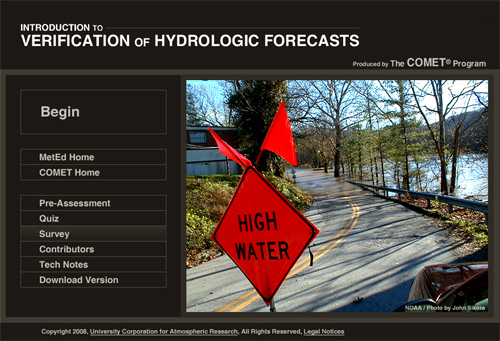Summary and Resources
To summarize, these two cases on verification of hydrologic forecasts provide an example of the techniques that may be used in verification studies.

http://www.meted.ucar.edu/hydro/verification/intro/
Let's recall from the Introduction to Verification of Hydrologic Forecasts that there are three main reasons that forecast verification is performed. One, to monitor forecast quality, which is to say, measure the agreement between forecasts and observations. Two, to improve forecast quality by learning the strengths and weaknesses of the forecast system, and three, to be able to compare one forecast system with another.
These cases demonstrated the use of verification as a way to monitor forecast quality for both deterministic and probabilistic forecasts. The cases also demonstrated using verification for the other two main reasons. We looked at how the forecasts and the data characteristics may need to change in order to improve the agreement between observations and forecasts. We also examined the impact of different input data and forecast scenarios and compared the different results.
This module showed the verification technique for one main question, how does QPF impact the hydrologic forecasts? But the verification techniques used can be applied to other questions about forecast quality and utility. The important take away message is to have an objective and a question in mind when beginning a verification effort. Then be prepared to look at multiple measures to understand the strengths and weaknesses of your forecast system, and how that system can be improved.
Congratulations! You have completed the Techniques in Hydrologic Forecast Verification module. Please remember to complete the quiz. We would also like to invite you to take a moment to provide us with your comments and feedback by completing user survey.
NOAA/NWS users please note: If you accessed this module through the NWS Learning Center, you must return to that system to complete the quiz in order to receive credit for completion.